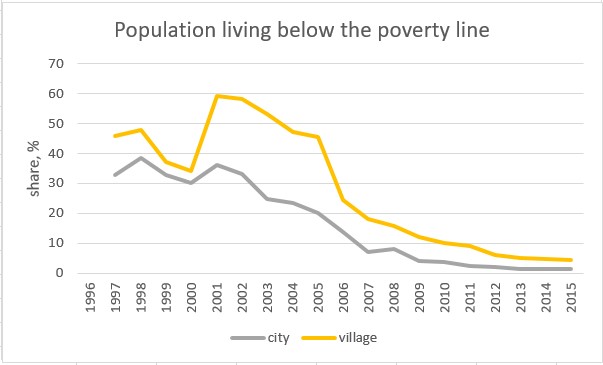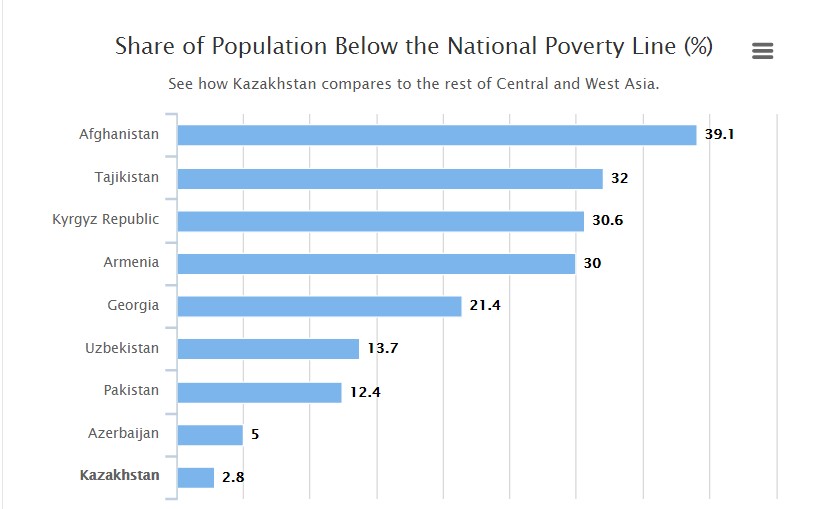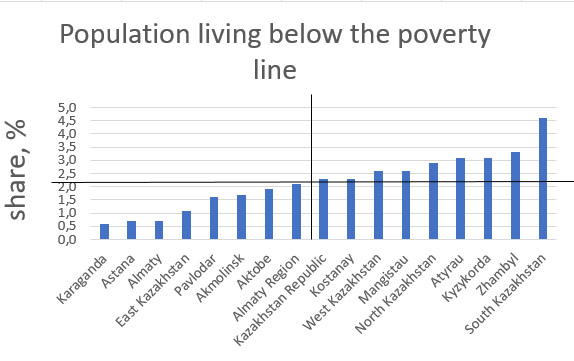One of the global trends discussed in the “Paradox of Progress” report (ссылка на доклад «Парадоксы прогресса») is called the “economy shift”. In real practice, this term means the economic slowdown of the industrially developed countries with good social infrastructure.
We discuss the causes of the world economic slowdown in the article “Seven Trends That Will Change the World”.
In the second article of the Global Trends.KZ series we will consider how this trend will affect Kazakhstan.
Where Did Poverty Go?
Kazakhstan is no exception to the world global trend, the number of the poor in the country is reducing. Based on the official data, the process had already started in the beginning of the 2000s when the percentage of the poor in Kazakhstan was very high. In 2000, about half the population was living below the poverty line.

Source: Kazstat
Currently, only 2.8% of the Kazakh population is living below the poverty line. However, we must clarify that the poverty line standard is significantly lower in Kazakhstan than in the rest of the world. For instance, World Bank considers the daily wage of about $1.9 per person as the poverty line standard. But, in Kazakhstan, the poverty line standard means 40% of the subsistence minimum and currently amounts to 9 thousand tenge (less than a dollar per day). This formidable achievement of the national statistics allows for the effective presentation of the country’s social development in the public space. It does not, however, permit to effectively evaluate this development and help the strategic decision-making.
Still, one way or another, against the background of its neighbors, Kazakhstan looks quite presentable.

Source: Asian Development Bank
For the political future of any country, its internal differentiation is crucial. In Kazakhstan, it has a clearly defined regional and less obvious, yet still evident, national color.

Source: Kazstat
As we can see, the biggest part of the population with the income less than the subsistence minimum lives in the two southern regions. The “oil-making” provinces belong to this group as well (probably due to the drift of the non-qualified labor in search of work). The lowest percentage of the poor lives in the capitals and in the areas with high percentages of the Russian-speaking population.
This pattern does not promise anything good even in the nearest future. Still, no serious research on this subject exists at this point. Therefore, it is very hard to evaluate not only the actual level of poverty but the future development of this index as well.
Between Poverty and Middle Class
The squeezing of the middle class is yet another global trend today, the NIC analysts say. Kazakhstan, however, heard nothing about the middle class squeezing. As for determining the size of the middle class in the country, these estimates differ exponentially.
The simplest of them is the “arithmetic” one although it is usually called “economic” for some reason. It helps to identify the “middle group” at the income distribution diagram. Therefore, the existence of the middle class, when using this method, is guaranteed whatever the absolute numbers are. Based on this method, the middle class amounts to about 40% of the people and is quite stable.
Those sociologists who try to include not only the income structure but the “expenditures matrix” into their analysis say that the middle class today consists of about 20% of the population. Following their conclusions, Nazarbayev too speaks about the same number. At that, the president demands that the number must be increased more than twice, up to 50%. In essence, it is the demand to enter a new stage of the social development since this number represents the percentage of the middle-class people in the developed countries.
Indirectly, we can evaluate the social development in Kazakhstan using a different method. It is believed that the middle class spends on groceries not more than 30% of their total expenditures. Therefore, given the income growing and the social up-shifting in Kazakhstan, this index should decrease upon average.
Currently, in Kazakhstan (based on the 2016 fourth quarter statistics), the average level of the wholefoods expenditures amounts to more than 44% (with more than 46% in the villages). Nominal incomes are rising. The level of the protein consumption is increasing in physical terms but the so-called carbohydrate stagnation is taking place at the same time. It means that the rise of incomes does not lead to the wholefoods expenditures decrease in family budgets. Instead, it leads to the re-phasing the consumer basket. Indirectly, this confirms that poverty is decreasing in the country but disaffirms that the middle class is rising (in other words, the class of people who had basically “stuffed themselves”).
Curiously, this trend seems to copy not the Western but the Soviet social pattern. Though due to quite different reasons, the Soviets, while increasing their incomes, the level of education, and the general demands, had not been able to “shoot their way” out of the consumer basket. The people had to spend significant resources to buy groceries. This humiliating state of affairs was a product of the system of total deficit. Today, the deficit does not exist but the trap of this trend is still there.
The Unbearable Lightness of Debt Burden
The NIC analysts consider the debt burden to be one of the trends that slowing the economy down by trapping family budgets in the Western countries. It is limiting the demand and slowing down investments in new capacities. The same process albeit at a smaller scale is developing in Kazakhstan as well.
The situation with mortgage credit lending in Kazakhstan should be analyzed in complete accordance with the theory of the intermediate class that had left poverty but never reached the middle-class status. In reality, the mortgage lending level is quite low. The summary total of the mortgage debt in the country amounts to about 1 billion tenge (in other words, not more than 60 thousand tenge as per person). Nonetheless, the classic mortgage lending market in Kazakhstan is considered to be exhausted and its further development is believed to be leading to the bank system bankruptcy or the social revolution.
The Aftermath Will Tell
The global economy slowdown is associated with Kazakhstan both as a cause and an effect. First, the materials sectors of the world economy not being an independent factor of the development will become the most obvious victims of the slowdown.
As we know, in the beginning of the last century, kerosene was the main product of oil refining. It was consumed by city authorities who used it for street lighting. The lighter fractions were simply burned on the spot. The fate of oil seemed rather unenviable after the invention of electric lighting – that is up until explosion motor cars had appeared on the streets.
The materials sector is exactly what determines the financial and, by extension, the social system in Kazakhstan. The latter had been radically transformed, it left behind the legacies of the Soviet and the post-Soviet eras when it was tight to the budget income or to nothing at all. Nonetheless, it is still early to call the social system in Kazakhstan an autonomous one, especially given all the indication of the reverse – the governmentalization and the centralization of the economy. Therefore, the global slowdown effect will soon affect every family in the country.
Read the first article of the series here Global Trends. KZ. The Future Comes from the South




